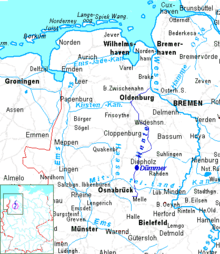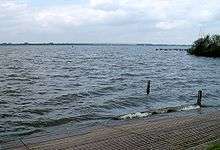Hunte
For the surname, see Hunte (surname).
 | |
| The Hunte in the Wildeshausen Geest | |
| Location | Lower Saxony, Germany |
|---|---|
| Length | 189 km (117 mi) |
| Source | Wiehengebirge 52°15′36″N 8°20′33″E / 52.26000°N 8.34250°ECoordinates: 52°15′36″N 8°20′33″E / 52.26000°N 8.34250°E |
| Source height | 185 m above sea level (NN) |
| Mouth | Elsfleth 53°15′10″N 8°28′44″E / 53.25278°N 8.47889°E |
| Mouth height | 0 m |
| Descent | 185 m |
| Basin | Weser |
| Progression | Weser → North Sea |
| Catchment | 2,785 km2 (1,075 sq mi) |
| Right tributaries | Wagenfelder Aue, Ollen |
| Left tributaries | Haaren, Lethe |
| Lakes passed | Dümmer |
| Cities | Oldenburg |
| Large towns | Melle |
| Small towns | Diepholz, Wildeshausen, Elsfleth |
| Population in catchment | 432000[1] |
| Navigable | between Oldenburg and Elsfleth for Europa Ships and coasters; as far as the Coastal Canal (Küstenkanal) for ships up to 1000 Brutto Register Tonnage |
 | |
The Hunte in Oldenburg
The Hunte is a 189-kilometre (117 mi) long river in north-western Germany (Lower Saxony), a left tributary of the Weser. It rises in the Wiehengebirge hills. In the Northern German Plain it flows through lake Dümmer. It flows generally northwards through the towns Bad Essen, Diepholz, Wildeshausen and Oldenburg. It flows into the Weser in Elsfleth. The part between Oldenburg and the Weser is navigable for coastal cargo ships. The Coastal Canal (Küstenkanal), suitable for inland navigation only, links the Hunte in Oldenburg to river Ems near Papenburg.

Lake Dümmer
References
- ↑ Flussgebietsgemeinschaft Weser: Bewirtschaftungsplan Flussgebietseinheit Weser 2005 – Bestandsaufnahme Teilraum Tideweser
This article is issued from Wikipedia - version of the 5/17/2016. The text is available under the Creative Commons Attribution/Share Alike but additional terms may apply for the media files.